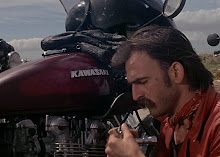In the early days of the Japanese superbike era, the bikes really didn't look much different from their weaker siblings. In fact, the early superbikes looked positively dull and ordinary.
That all changed, however, thanks to two Germans and a Swede.
Suzuki's reputation has generally been one of quality and engineering. They have always done things a bit differently, as well. Suzuki tried to join the superbike race with a liquid-cooled two-stroke, the GT750. They also tried to join the burgeoning touring bike segment with the Wankel rotary-powered RE5. Both bikes were strong performers on the road but they couldn't match that performance in the showroom. Eventually, Suzuki joined the club with their own range of four-stroke four-cylinder bikes.
Suzuki's new range, the GS series, received critical acclaim for their balance of speed and handling. Kawasaki's were very fast but their handling was poor. Honda had good handling but sub-par performance. Suzuki had found the magic combination that allowed four-cylinder power without the awful four-cylinder handling.
One thing the GS series didn't have was interesting styling. The GS bikes were styled very conservatively and that gave Suzuki an image of stodginess. Superbikes were supposed to be loud and fast. Suzuki's superbikes looked like Japanese BMWs. Something had to be done.
Enter the aforementioned two Germans and the Swede.
To enhance Suzuki's image, the company hired former BMW stylist Hans Muth to work on some concepts. Muth and his cronies Jan Fellstrom and Hans-Georg Kasten made up Target Design. The three designers worked with the ideas of a sloped forward nose and a fuel tank that blended into the seat. Special emphasis was placed on aerodynamics, especially in high-speed situations. The early concepts were extensively wind tunnel tested in Italy. The original concept, the ED-1, was based around a 650cc engine. In 1980, ED-2 was displayed at the Cologne Motor Show and was now based around a 1,100cc four-cylinder engine from the GS1100.
One-year later, the production version hit the street and the world was never the same. This new superbike, christened Katana, was unlike anything the motorcycling community had ever seen. The nose ended in a sharp point, leading to a square headlight that had a small wind deflector on top of it. The large fuel tank had an offset fuel filler that was styled after fuel fillers used on aircraft. The fuel tank also blended seamlessly right into the seat, which then ended in an abruptly squared-off tail. Rear-set pegs and clip-on handle bars allowed for the classic racing riding position while the rider faced a unique gauge cluster with an overlapping tachometer and speedometer. Silver was the only color offered and the tank came complete with Suzuki on the sides in big, red letters.
Underneath the distinctive styling was a 998cc four-cylinder engine churning out 108hp. Soon the engine was bored out to 1,100cc. With prodigious power and a wide-ratio 5-speed transmission, the Katana was good for speeds over 140mph. Nothing in 1981 could even come close to that kind of speed.
There were a few downsides, though.
The styling of the new Katana was so unlike anything else at the time, the public wasn't sure what to make of it. A riding position straight off the race track was a turn-off for some. Weight was also an issue with the bike weighing over 530lbs ready to ride. By 1984, the Katana was gone from Suzuki's lineup.
The Katana's influence, however, has been felt ever since. Suzuki used elements of the Katana's design in some of it's smaller GS bikes during the eighties. If you look at any superbike in one of today's showrooms, you'll see the gas tank blend seamlessly into the seat just like the Katana's. The Katana evolved into Suzuki's revolutionary GSX-R line that is still produced today. The Katana name was revived in 1988 on a line of sport-touring bikes produced until the early 2000's. The Katana name also appears on a Suzuki scooter.
In terms of production, the original Katana was a blip on motorcycling's radar. In terms of influence, the original Katana was a milestone in motorcycle design. The Katana directly influenced design for over thirty years and helped lead the way toward Suzuki's most well-known model line - the GSX-Rs.
This is a 1982 Suzuki GS1000S Katana. The skinny wheels were standard GS1000 but the rest of the bike was unique. It's easy to see why the Katana caused such a stir. Motorcycle design hasn't been the same since.
Subscribe to:
Post Comments (Atom)


No comments:
Post a Comment